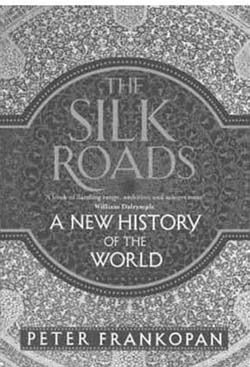Billed as a ‘new history of the world’, this ambitious attempt at chronicling a version of world history from the perspective of the Eurasian Trade Routes is a great text. Peter Frankopan prefaces the book by condemning the excessively Eurocentric approach to traditional history writing as an explanation for this work. Outlining his dissatisfaction with the way history was taught, he talks about how as a child he had a world map in his bedroom. It was this map which showed him how many regions of the world had been passed over in silence as they studied history beginning from the Ancient Greeks and Romans to the Romans in Britain, the Norman Conquest on to the Tudors, the American Revolution and then to World War II. As a student of History from India one cannot help but sympathize with the view. Even though Europe is only one of the foci of our syllabi, vast regions of the world, and several centuries, remain untaught for most students. Frankopan’s book is an excellent introduction to someone looking to study History from a more global perspective, rather than the regional-national narratives prevalent in our syllabi.
The book has an interesting perspective on studying history. It focusses on neither a specific region, nor any group or peoples, but on, as the title suggests, the Silk Roads. Perhaps the first thing that emerges from this approach is the fact that Silk Road is used as a plural rather than a singular. There was no one Silk Road in history, there were many—a shifting and evolving trade network that would influence the Ancient world and our modern contemporary eras in equal measure.
The book begins with the Ancient period, with the Persian Empire and the conquests of Alexander the Great, and then marches through the ages right up to the modern era, detailing the origins and problems of the aftermath of 9/11 American invasions of Afghanistan and Iraq. Where many authors would have required multiple volumes to accomplish the task, Frankopan manages to do it in a single book. Without giving an in-depth read into any one culture, it explores its fundamental premise rather well—of the study of various cultures, of the rise and fall of civilizations, and the impact of momentous events and the relationship of all of these to the Silk Roads of history, and in turn the influence of the Silk Roads in shaping cultures and trends. Moreover, while these links and their melding influences are presented coherently, the book maintains its adherence to progressing chronologically. Thus you will not see an analysis of the Mongols before you can understand the spread of Islam, and the analysis of Islam doesn’t get confused with the interactions of Rome’s Christianity to Persia’s Zoroastrianism. The book does not just discuss slaves or trade in a Central Asian or European context—each subject is covered from one end of the road to another. However, the author makes sure that once he begins an analysis he does not leave it hanging for later discussion, just because chronology intrudes. It is a problem many historians have to grapple with. When they look at processes, the chronological evolution of events often results in breaks or even reversals for the overall process. Reconciling the breaks in time while still presenting a complete picture of the process can be difficult, and necessitates balancing the two. Frankopan handles this problem rather well. The diffusion and interactions of religion and its consequences are presented cohesively, and yet adhere to the chronology of history.

